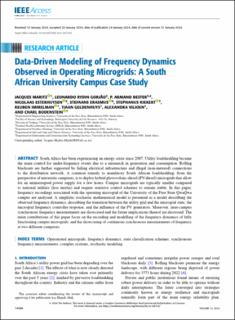| dc.contributor.author | Maritz, Jacques | |
| dc.contributor.author | Gorjão, Leonardo Rydin | |
| dc.contributor.author | Bester, P. Armand | |
| dc.contributor.author | Esterhuysen, Nicolaas | |
| dc.contributor.author | Erasmus, Stefaans | |
| dc.contributor.author | Riekert, Stephanus | |
| dc.contributor.author | Immelman, Reuben | |
| dc.contributor.author | Geldenhuys, Tiaan | |
| dc.contributor.author | Viljoen, Alexandra | |
| dc.contributor.author | Bodenstein, Charl | |
| dc.date.accessioned | 2024-02-12T10:38:28Z | |
| dc.date.available | 2024-02-12T10:38:28Z | |
| dc.date.created | 2024-02-02T12:37:22Z | |
| dc.date.issued | 2024 | |
| dc.identifier.citation | IEEE Access. 2024, 12 14466-14473. | |
| dc.identifier.issn | 2169-3536 | |
| dc.identifier.uri | https://hdl.handle.net/11250/3116844 | |
| dc.description.abstract | South Africa has been experiencing an energy crisis since 2007. Utility loadshedding became the main control for under-frequency events due to a mismatch in generation and consumption. Rolling blackouts are further supported by failing electrical infrastructure and illegal (non-metered) connections to the distribution network. A common remedy to mandatory South African loadshedding, from the perspective of university campuses, is to deploy hybrid photovoltaic-diesel (PV-diesel) microgrids that allow for an uninterrupted power supply for a few hours. Campus microgrids are typically smaller compared to national utilities (less inertia) and require sensitive control schemes to remain stable. In this paper, frequency recordings associated with the operating microgrid of the University of the Free State QwaQwa campus are analysed. A simplistic stochastic mathematical model is presented as a model describing the observed frequency dynamics, describing the transition between the utility grid and the microgrid state, the microgrid frequency controller response, and the influence of the PV generators. Moreover, inter-campus synchronous frequency measurements are showcased and the future implications thereof are discussed. The main contributions of this paper focus on the recording and modelling of the frequency dynamics of fully functioning campus microgrids, and the showcasing of continuous synchronous measurements of frequency at two different campuses. | |
| dc.description.abstract | Data-Driven Modeling of Frequency Dynamics Observed in Operating Microgrids: A South African University Campus Case Study | |
| dc.language.iso | eng | |
| dc.title | Data-Driven Modeling of Frequency Dynamics Observed in Operating Microgrids: A South African University Campus Case Study | |
| dc.title.alternative | Data-Driven Modeling of Frequency Dynamics Observed in Operating Microgrids: A South African University Campus Case Study | |
| dc.type | Peer reviewed | |
| dc.type | Journal article | |
| dc.description.version | publishedVersion | |
| dc.source.pagenumber | 14466-14473 | |
| dc.source.volume | 12 | |
| dc.source.journal | IEEE Access | |
| dc.identifier.doi | 10.1109/ACCESS.2024.3357945 | |
| dc.identifier.cristin | 2242582 | |
| cristin.ispublished | true | |
| cristin.fulltext | original | |
| cristin.qualitycode | 1 | |
